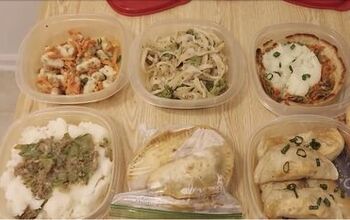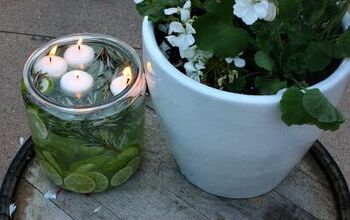Why You Shouldn't Use a Recipe & 6 Frugal Meals to Prove It

What’s missing from a lot of meal planning on a budget and cook-from-scratch information is this: how to rely less on a recipe. There, I said it.
Think about it— the less you rely on a recipe because you understand the foundational components of building a meal with what’s already in your pantry, the more you’re really cooking from scratch. Honestly, a lot of us have ingredients in our kitchens, but we just can’t see how to put them together.
It’s okay; I’m here to help with that. I’m here to prove that you can absolutely cook without a recipe. In fact, in this video, I’m sharing six meals that you can make without one.
And to be clear, I’m talking about real food, like a chicken tortilla bake, a creamy onion soup casserole, and a meat-and-tomatoes pasta pot. Don’t worry— my detailed guidance will ensure you can whip up something just as delicious in your kitchen.
This will help you stand in front of your fridge or pantry and see how to work with the ingredients and amounts you have on hand, or can substitute, to make something just as good.
Table of contents
Shop Your Pantry First
Before you even think about going to the grocery store to meal prep, you better raid your own pantry. My tone might sound restrained, but if your kitchen routine doesn’t start with this every single time, you know what that means, right?
You’re likely tossing food that’s spoiled because you didn’t use it in time, or you’re buying things that sit for weeks or years and eventually go stale. Both of those options are synonymous with throwing money in the trash.
Shopping your house first prevents this. Here how I do it:
1. Put Ingredients into Bins
Here’s what my routine looks like: I always start by grabbing my fridge bins and pantry basket. I keep three bins in my fridge that organize the ingredients I’ll need for each of the three meals I plan to cook that week. In addition to these meals, I also have a Crockpot night, a freezer meal night, and a leftovers night.
2. Prioritize Soon-to-Expire Items
I grab another basket for soon-to-expire or surplus ingredients. This week, I’ve got some collard greens from last week, a bit of Parmesan cheese, some corn tortillas from a different meal, and some multigrain bread. Whatever I plan to cook or snack on must include these ingredients.
3. Plan Meals
Meal 1: Tortilla Lasagne
I slide my tortillas into the first fridge bin, then head over to my cabinet where I keep my home-canned goods. I’m going to reimagine those tortillas as lasagna layers and create a creamy chicken sauce. Two pints should be enough, so into the fridge bin they go. I’ll need some sour cream to lend creaminess and body, so I put this in the bin, and then—oh, I’ve got it! I’ll blend it with some corn cob broth. When heated together, these ingredients emulsify beautifully to create a cohesive, flavorful sauce.
Meal 2: Cauliflower Casserole
I’ve had a batch of fermenting cauliflower in my fridge that I want to use. We’ve enjoyed batches of it raw, but I think I’m going to go ahead and cook it and slide it into a casserole using some noodles that I want to use up. I transfer the noodles to a reusable bag that I tuck into my fridge bin. Then, I head back to the pantry to grab some protein. I love pairing chicken and cauliflower, and now I can fold in that bit of cheese I have on hand.
But I still want to up the textures and flavors, so let’s head to my larger downstairs pantry to grab some mushrooms. Goodness, I love mushrooms, and these have been marinating in beef broth and herbs.
Okay, I see the casserole coming together, but let’s fancy it up a bit with a crunchy layer on top made with some panko breadcrumbs. To save time, I’ll also eyeball a portioned amount. Yes, another meal using what I already have is assembled and ready to go.
Meal 3: Cheesy Pasta
Having recently come off the holidays, I have an assortment of cheeses that I grabbed for hosting but really aren’t my everyday ones. I want to go ahead and use them up, so they don’t sit for too long. I’m going to mix, match, and melt these down into a creamy, cheesy dish that also uses some pasta.
A cheese sauce needs two other things: butter—so I’ll toss that in—and some type of liquid. Since we’ve got milk, I’ll set some aside so that it’s there when I need it. I use wet bottles that are excellent and 100% leak-proof for so many things. That goes in the fridge bin too.
I remembered that I had these noodles in my long-term storage, and since I’m not sure what this will be, I’ll grab some onion soup to connect the flavors and save me from dicing and chopping them later on.
I’ve got to use these collards, so I think I’ll create a side dish straight from the main jar. Excellent! My third bin is complete.
Snack: Toast with Jam
Now, all I have in my leftovers basket is some bread—I’ll toast it with butter and spread it with some strawberry jam. That’ll get eaten.
Shopping my fridge and pantry showed me that I have three meals ready to go this week. I don’t need to go to the grocery store because I have everything we need. Let me place the fridge bins back in the fridge. I have solved the “What’s for dinner?” question and won’t have to be a frantic last-minute cook.
Just so you know, I don’t keep a complicated fridge. I stick with the basics, which ensures that I nearly always have or can create a rendition of anything. I share this because my fridge only houses items that must be refrigerated, in amounts that I know we can work through. Everything else is either fermented, frozen, or canned, which gives me time to purchase it on sale, preserve it, and then plan to use it as you see me doing here.
Now, I know some people might object to keeping bins in the fridge because, from the outside looking in, it does look kind of extreme. But I’m telling you, once you try it, you’ll likely be hooked.
When I leave work at the end of the day and commute home, I no longer have to do that mental dance of trying to think about what’s in my fridge that I can use to make a meal.
When I get home, I can just kick off my shoes, put on my apron, and there aren’t any distractions or obstacles to getting the meal started because all I have to do is take out the bin, and there it is—I’m ready to get going.
Chicken Tortilla Lasagne
Now, let’s cook. You’re about to have dinner envy with this homestyle chicken lasagna. Are you ready to make this gravy? Remember this sequence: you want a fully flavored fat, fluffy flour, and a boldly flavored broth.
Melting butter or bacon grease creates a smooth base to coat the pan and prevent burning. Then, adding flour makes a roux. This also cooks out the raw taste and activates the thickening properties.
Only add enough flour that the butter can handle until you get a chunky batter like this:
Next, slowly pour in a boldly flavored chicken broth to achieve your perfectly smooth gravy. This sequence prevents clumps and enhances flavor.
If you need to stretch it or if you want it creamier, slowly add full-fat milk or cream, then season with a bit of salt and pepper to taste. Oh yes, that’s it—that is perfect:
Now see how simple that was to make? And here’s the spoon test: if it doesn’t immediately run off, you’ve achieved the perfect consistency.
Now, if you don’t pressure-can your own chicken, you may be using leftover cooked chicken, but I love having fully cooked proteins on my shelf. This was an Italian-seasoned chicken breast that I canned from the markdown meat section this summer.
It is so moist, fully cooked, and has been marinating in its own juices. Add whatever amount of chicken you decide to your gravy, but if you’re using canned, dump your broth right into the mix.
I use garlic and onion in almost every meal, so I’m tossing some minced garlic in, and then an onion that I quickly diced. Now, to take this gravy over the moon, I’m going to stir in some sour cream. It’s going to make this super creamy and lend a bit of that tangy flavor that will pair nicely with the tortillas.
There you go—look at you! You just made a chicken gravy that could be eaten on a sandwich, with nachos, ladled over rice...I mean, you’ve got options. Okay, let’s get to those tortillas. Remember, I’m building out a casserole, so I’m going to take my pan and layer a portion of the chicken gravy along the bottom, then place the tortillas on top.
I’ll sprinkle on some cheese, which will add flavor and glue these layers together, so to speak. Then, I’ll keep layering like this until I reach the top of the pan.
And just a bit of real talk—I’ve combined tortillas with lasagna noodles when I didn’t have enough of either. Sometimes the layers are mashed potatoes. I’m telling you, this recipe cannot be tamed. You likely have the ingredients I’m using in your kitchen, so this could be on your table tonight.
Bake it at 350 degrees for 15-20 minutes until the tortillas puff up, and the cheese is melted.
Now, I had a little bit that wouldn't fit into the pan, so I just went ahead and froze it as a single serving meal:
I can't tell you how much I love this meal, and when I say "this meal," I mean all its many iterations. It's flavorful, comforting, and perfect for any occasion—company, weekdays, weekends—and it will fill you up. You've got to let me know when you try it!
This dish came about because I always have tortillas on hand—Taco Tuesday is a real thing around here. It's just another meal staple I love because I can stuff whatever meat—chicken, fish, beef, or beans—with whatever toppings—fresh or fermented beans—and sprinkle it with cheese, and dinner is done.
Instead of trying to buy a specific ingredient that only does one thing, I love seeing how many ways I can use a single ingredient. Doesn’t this look good?
Cauliflower Casserole
Okay, let's get to our next fridge bin. See how having your ingredients out lets you get right into things?
Now, I’m going to start cooking my pasta, and when the noodles are tender, I’m going to add my fermented cauliflower—yes, this is actually an orange variety, that’s not just how it looks on camera:
I’ve had this cauliflower since November, by the way. Now, yes, it will lose its probiotic goodness, but it’s still fresh, so I never worry about only using my fermented items for their probiotics.
The reason I’m scooping my cauliflower out is that you can absolutely reuse your brine. I mean, I’ve already got marinated flavors in there, so I’ll just tuck it back in the fridge. I’ll find something to dice and dump in there in no time.
It’s time to get my sautéed medley going, so in my cast iron, I’m going to add some bacon drippings and sauté some diced onion and garlic to create my base layer of flavoring.
Next, I’m going to add my home-canned mushrooms, drain my now-tender cauliflower and pasta, and prepare to make a cheese sauce by sprinkling a bit of flour onto the mushroom mix, slowly adding my home-canned broth, and letting that simmer.
Then, to thicken things up and give me a bit more sauce, I’m going to add some cream and season with a bit of pepper.
Again, the chicken is fully cooked, so I add it towards the end. Y’all, home-canned chicken just smells the best; I love it.
Alright, our work here is almost done, so I’m going to add the noodles and the cauliflower. Again, no measurements—I’m just trying to see how much I can fit into my pan with the sauce that I have.
And since I have extra noodles, I went ahead and let that current batch sit in there, scooped it out to make a freezer meal, and then added the other noodles since I still had enough sauce.
This last part is totally optional, but I love to make a crunchy panko bread topping by combining just some melted butter with a little bit of cheese and breadcrumbs, and then I thoroughly combine that and sprinkle it on top to bake.
Do you see how this is another easy, open-ended meal that can use whatever vegetables, whatever pasta or protein you have on hand? It’s easy to create a little Everyday Gourmet when you realize that not following a recipe doesn’t spell a dinner disaster.
Tip: Create Extra Portions
Let me pop in here real quick just to flag something you may have already picked up on—my meals this week do lean heavier on the pasta and carb side. It’s not my preference, but it happens from time to time, and actually, I’m okay with this.
As I’m cooking, you’re noticing that I’m taking a portion and sliding it off to make freezer meals. So, I’m not only preventing the fresh food I currently have from spoiling, but I’m also going through what I currently have and rotating that inventory.
I’m cooking a meal for tonight and stocking up our freezer rotation. I’d say accomplishing all that alongside a weekday 9-to-5 ain’t bad. Plus, I usually just grab a jar of something fermented and make that half my plate.
Cheesy Pasta
Here’s our third meal, but I’ve still got three more meals and a breakfast leftover recipe to share with you. Let’s get these noodles going since it’ll be the longest step in this meal.
In another pot, we’ll melt the butter, sprinkle in some flour and milk to create a white sauce—a white sauce is perfect for all things noodle and so much more.
After I add the milk, I’m going to grab my cream of homemade mushroom soup—yep, I make and freeze my own for pennies—and pour that in along with a few random cheeses that were originally intended for a Christmas charcuterie board.
I only need half, so I’ll put the other in the “use first” bin for next week.
Using a combination of cheeses will create a dynamic flavor, but don’t get too hung up on it—please taste and season as you go.
Here’s another tip: always add a bit of Dijon mustard to a cheesy white sauce. The acidity and sharpness from the mustard will help cut through the richness of the white sauce and prevent it from becoming overly heavy. Then, add your French onion soup mix to thin things out a bit and add texture.
I wanted to add in some vegetables, so I rummaged through the freezer and found some mixed vegetables—I poured the whole bag in. Believe it or not, this meal is done—the flavors are incredible and ready to pair alongside a pork chop, fish, a salad, or soup.
Spaghetti Stew
This next dish is like a spaghetti stew. I pulled out some meatballs that I had in the freezer, and sometimes the sauce is either tomato, Alfredo, or pesto.
The veggies are always changing, and the pasta doesn’t matter. After you’ve chopped whatever you need to use up, along with some onion and garlic, you’re just going to create your flavor base and then add your vegetables to sauté.
I just need a little bit of chicken broth, so I’m going to take a shortcut and use my bouillon base to stretch out the limited amount of sauce that I have.
Okay, we’re going to let those flavors meld, then drop in our meatballs, and after that, our pasta.
Next, we’re going to season things up, and this is to taste, so here’s what I used: white pepper, celery salt, and Italian spices. Y’all, this meal is done—it’s like a brothy spaghetti stew:
Tip: Don’t Use Precise Measurements
I hope you’re starting to see that it’s probably not another cookbook or recipe you need, because in fact, the practice of having precise measurements for recipes is really a recent thing.
In early American history, there was a lack of standard measurements for ingredients. While some cookbooks may have included vague terms like a handful or a pinch, others didn’t include any at all, reflecting the reality that cooking was taught through oral tradition or hands-on experience rather than the written recipes we’ve come to expect today.
This makes sense, right? Just a few generations ago, you were only cooking with ingredients you could get locally or that you grew yourself, so recipes were always changing based on what was in season or what was available.
As a result, precise measurements were less crucial because you were only ever cooking with what you had on hand. Our great-grandparents didn’t have access to grocery stores with produce shipped from all over the world, and you know what? They made some pretty darn delicious meals without a recipe in sight.
Cookbooks
Books like American Cookery by Amelia Simmons (1796), The Virginia Housewife by Mary Randolph (1824), and The Kentucky Housewife by Lettice Bryan (1839) all featured recipes with flexible measurements, trusting the cook’s intuition and experience.
In these books, you’ll frequently find directions that read something like, “Green peas should be boiled from 20 minutes to 60 according to their age,” and “Tomatoes should be skinned by pouring boiling water over them; after they are skinned, they should be stewed half an hour in tin with a little salt, a bit of butter, and a spoonful of water to keep them from burning.”
One of my favorite cookbooks is The Frugal Housewife by Lydia Maria Child, published in 1829. She’s my kind of gal—blunt, but in a way that a true friend would tell you that you’ve got spinach between your teeth. She says it because she cares.
For example, she really gets on you when she says, “Make your own bread and cake. Some people think it’s just as cheap to buy of the baker and confectioner, but it is not half as cheap.
True, it is more convenient, and therefore the rich are justifiable in employing them, but those who are under the necessity of being economical should make convenience a secondary object.”
I really wish cookbooks would return to their roots. Today's cookbooks, while visually stunning with their beautiful photography, often miss the mark. They tend to blend seasonal foods in ways that drive up costs and focus on expensive cuts of meat.
If you’re serious about home cooking, these guides don’t necessarily make meal prep more efficient or economical. Instead, I advocate for curating a small collection of cookbooks that emphasize practical, seasonal eating and food preservation methods. These are the true gems.
When you join me in my kitchen, my goal is to help you become a more critical and clever cook. Recipes should be a springboard for creativity, not a rigid set of instructions. You’ll often see me go rogue, cooking without a measuring cup in sight.
Yes, I’m happy to share recipes, but I’m also candid about how my versions evolve. The key is to focus on overall kitchen efficiency rather than obsessing over a single plate. A dabble of this and a sprinkle of that might seem unsophisticated, but these flexible skills are incredibly powerful.
Lamb/Chicken Soup
Even during a week of using up leftovers, I still manage to pull something from the freezer. Recently, I found a great deal on lamb legs at the grocery store.
I turned them into a quick crockpot stew with fresh veggies I had on hand, creating a tender, flavorful chicken soup. Scoring organic chicken broth for just under a dollar made it an even better deal.
The soup turned out so tender, and the vegetables were perfectly flavored—proof that home-cooked meals can be both affordable and delicious.
Quick Garam Masala Marinade
Sometimes, when I have chicken that I can’t process immediately or want to prepare a quick freezer meal, I’ll make a marinade before freezing.
Tonight, for instance, I’m whipping up a garam masala sauce with a can of tomato paste, two cans of diced tomatoes, and a can of coconut milk.
I’ll add garam masala, turmeric, garlic, cumin, red chili flakes, and a dash of salt, then mix it with pickled ginger to get the flavor just right. This mixture will go into a freezer bag with the chicken, ensuring another economical meal is ready for the future.
"Breakfast" Hashbrown Bake
Breakfast can also benefit from a bit of creativity. I use my manual grater to make hash browns, a more cost-effective option compared to frozen ones.
Once grated, I cook up some pasta, breakfast sausage, and toss in clearance peppers and onions.
I mix these with cream cheese and a variety of cheeses I already have on hand. To top it off, I add a hash brown topping before baking.
This dish, which I prepared a week after my true leftover week, smells just like breakfast and is perfect for a cold, snowy morning. If there are leftovers, I freeze them for convenience later on.
More Resourceful Kitchen Tips
In summary, I hope you see that as I cook, I’m constantly creating and leveraging preserved ingredients to make future meals easier and faster.
If you’re looking to be more resourceful in your kitchen or want to explore how historical preservation methods can outshine modern gadgets, please subscribe to my YouTube channel.
You can find links to some of the products and cookbooks mentioned above in the video description box here.
I'll see you in my kitchen or garden soon. Take care, friends!




































































Comments
Join the conversation